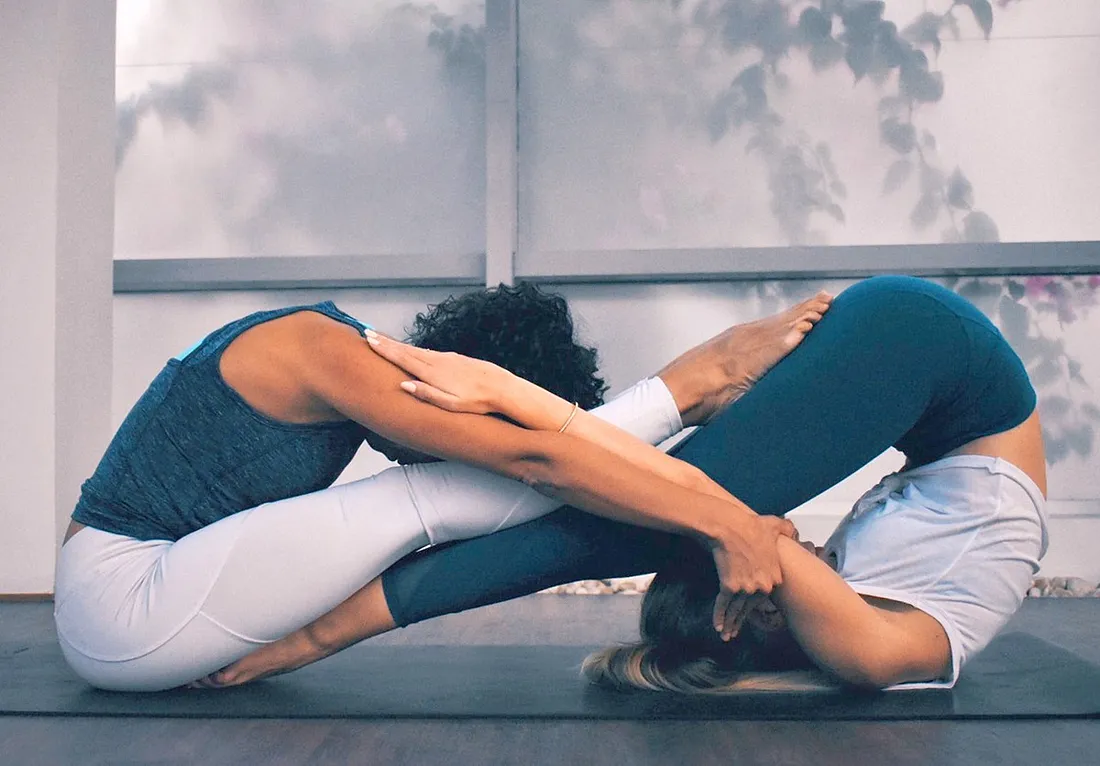My flexibility increased dramatically after I started practicing yoga. Almost a decade after I started, I am much more flexible than I was when I began. So, a common question that surprises people is whether yoga is just stretching.
Yoga involves a great deal of stretching. This means that you will most likely see an improvement in your flexibility over time. Yoga can provide much more than just stretching.
Yoga is a great way to become more versatile.
There’s more to it.
Yoga in ancient India was not primarily about the poses. The primary goal of yoga was not health. It was removed! Yoga practitioners instead focused on other practices, such as increasing religious vitality by utilizing breathing strategies and mental focus.
It is important to note that yoga today differs from the ancient Indian practice of 2000 years ago.
The fashion issues are tailored to the modern lifestyle.
Yoga can be taught in many different ways. Some yoga lessons may be more focused on the physical aspect of yoga. The trainer might not even know that this is the case.
In this article, I will try to present the various components that could be included in a more ‘full-fledged’ yoga class.
Stretching
Strengthening
Respiration
Gaze/Focus
Philosophical Terms
This article will cover the following: 1 Stretching, 2 Strengthening, 3 Respiration, 4 Gaze/Drishti and 5 Yoga Philosophy.
Stretching
Yoga practitioners usually do a variety of stretching exercises. They could be in the form of dynamic stretching, as in an Energy yoga class, or more static stretching, such as in a yin class.
There are many advantages to doing this.
Flexibility is an important element of human performance, not only for health reasons. Flexible tissue can better adapt to stress and improve the effectiveness of movement. This in turn helps to reduce and even prevent injury.
Without stretching, muscles shorten and become tight. It limits our range of motion and increases the risk of muscle injuries, joint pain, and strains. Restricted flexibility is the cause of musculoskeletal injuries and lower back issues. Yoga has many benefits for athletes, so it is no surprise.
In fact, many people with persistent low back pain have tight muscles in the lower backbone as well as tight hamstrings. Yoga is often prescribed for people with lower back ache because of this.
Yoga lessons will likely include many yoga exercises that help stretch the entire body. These yoga stretches can be beneficial to our overall health when we practice yoga regularly. Just observe how you feel after a session of yoga. If you start a yoga practice, you may experience some stiffness in the muscles. However, it will have a positive impact on your health.
Strengthening
Yoga is also known as body weight training. This means that we are supporting our body weight in our practice. It could be done on our toes.
Another example is the plank position. Our core and arms support the weight of our body. Over time, this exercise can help improve our energy.
In the more physically demanding yoga practices like Ashtanga and Vinyasa we are always lifting our own body weight and engaging our core throughout the practice. This can help build muscle over time as the constant practice will tone and strengthen muscle tissues all through the body.
In 2004, a study was conducted in the US on 26 participants between the ages 20 and 58 who were subscribed to six weeks of regular yoga. The participants were divided into two groups: those who practiced Ashtanga and those who practiced Hatha. The results confirmed that both groups showed an improvement in core strength and increased body energy. It’s not surprising that Ashtanga yoga had better outcomes, as it is a more physically demanding follow.
It is worth mentioning that the Ashtanga group also showed a reduction in their perceived stress levels.
Respiration
You could think of yogic breathing as the muse for our yoga observer. This issue is enough to distinguish yoga from a mere stretching program.
Each yoga class starts with an introduction to the breath.
When we are first taught how to breathe properly in a yoga session, it’s interesting to note that most people notice their breath being shallow. In general, we tend to breathe in the upper chest. This way, the depth of our breath is missed. We can also breathe into our stomachs and not allow the rib cages to expand, so we miss the peak of our breath.
You may be asking yourself: Why would I want to improve my breathing?
It is important to take deep breaths, allowing air to enter your lower lungs to deliver oxygen to the blood. This also activates the parasympathetic nerve receptors, which results in a slowed heart rate and adrenal glands that produce less stress hormones. This is one of many reasons why we feel calmer after a yoga session.
No matter how easy or difficult the pose may be, we must always keep the breath regular. Not just any breath. Clean, regular and balanced breath.
Gaze/Drishti
The gaze or drishti, as it is more generally known in the Ashtanga group of yoga, is an additional part that separates yoga from other bodily practices.
In a yoga class, it is easy to become distracted. It’s easy to get distracted in a yoga class. The drishti helps make the experience more personal, even in a large group of people.
By directing our attention inward, our drishti can help us to block out distractions from the outside world and enhance our awareness. By focusing on a still point, we can become fully present in the moment.
Each asana in Ashtanga has a corresponding drishti (level) as further defined below.
Drishti
Focus level
Asana
Nasagra Drishti The tip of the nose is used to deal with dogs upward
Hastagram Drishti the arms or ideas of fingers Trikonasana
Parsva Drishti: Left and Right Aspect In Yoga Poses involving Twists, the left or right aspect of our body is called Parsva.
Urdhva Drishti Look up or outward Virhabadrasana
Nabhi Drishti the navel downward dealing with canines
Padayoragram Drishti Padayoragram Drishti or our toes or the lines of our toes? Most forward bends
Bhrumadhya Drishti is the center of the forehead at the centre of the third eye. During meditation, observe the Ashtanga Drishti factors.
The combination of drishti with regular breathing helps us to anchor our thoughts and take our attention away from the normally noisy, inner thoughts.
Then, we can achieve sense withdrawal. This could be taken to the next level and mean accepting that external stimuli will never really satisfy us. Our yoga practice is leading us to the point where we realize that the fulfillment we’ve been searching for was already inside.
Yoga Philosophy
Last but not least, there is the yoga philosophy. Yoga is not just the physical practice that most people think of when they hear the word. It has a very rich history and philosophy.
If you’re lucky, you might find a yoga instructor who can tap into the depth of yoga philosophy. There are also academics who have dedicated their lives to teaching yoga philosophy, and many of them have written books about the subject. If this is something that interests you, I will write an article that recommends yoga philosophy books that can help take your practice off the mat.
We’ll look at yoga philosophy for a moment.
Yoga Sutras by Patanjali are widely considered to be an authoritative text on yoga. The Yoga Sutras were written almost 2000 years ago and consist of aphorisms that outline the eight limbs in yoga.
Sutra means thread in Sanskrit, so these threads provide hints for living a meaningful and purposeful existence.
The most famous sutra is probably:
Yogas chitta vritti nirodha
Yoga is a way to remove the fluctuation of thoughts. We are no more than our thoughts and emotions.
Yoga is the quieting of thoughts until they are ready for relaxation and tranquility. In this way, you can experience life as it is.
Patanjali teaches us to experience life through the clearest lenses. Lenses which are untainted by thoughts of good or bad, better or worse, old or new, my or yours. We are at peace with everything and everyone when we eliminate the fluctuation of our thoughts.
Yoga is a way to calm down the fluctuation of the body, the breath and the senses. In the stillness that we create, it’s possible to recognize the unhealthyness of our limited and self-limiting identity. Patanjali’s conclusion is that what remains, the self in its true essence, is what will remain.
Associated questions
What is the difference between different types of yoga?
Some yoga practices can be more dynamic than others. Ashtanga yoga, Vinyasa and Energy Yoga are all physically demanding practices. Hatha is less physically demanding and focuses more on static stretching. It depends on the instructor and the students present in the class.
Yin Yoga is a static practice that focuses on stretching connective tissues and improving flexibility. Restorative Yoga is a light-weight observe that uses bolsters and blocks to help the body relax in therapeutic and calming positions.
You might be interested in my article, Newbie’s Guide to The Trendy Varieties of Yoga and Their Benefits.
How do I choose the right class?
When I began my yoga practice, I found that I liked to recommend this to college students. Google “yoga + your city”. Check out what’s available and check out some yoga studios and academics. Most studios provide free tester lessons. You’ll hopefully find a studio, trainer or class that suits you.







